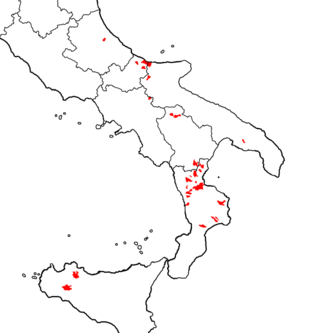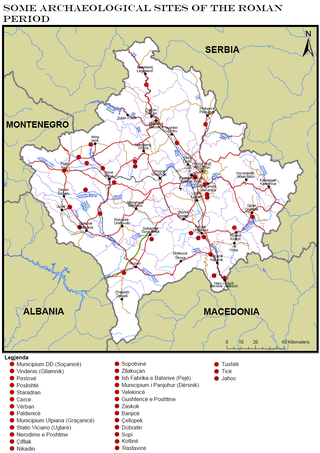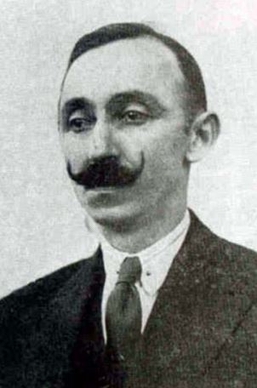Related Research Articles
The Kanun is a set of Albanian traditional customary laws, which has directed all the aspects of the Albanian tribal society.

The Arbëreshë, also known as Albanians of Italy or Italo-Albanians, are an Albanian ethnolinguistic group minority historically settled in Southern and Insular Italy.

Contessa Entellina is a small comune in the Metropolitan City of Palermo, in Sicily, southern Italy.
The origin of the Albanians has been the subject of historical, linguistic, archaeological and genetic studies. The first mention of the ethnonym Albanoi occurred in the 2nd century AD by Ptolemy describing an Illyrian tribe who lived around present-day central Albania. The first attestation of medieval Albanians as an ethnic group is in the 11th century.

Giuseppe Schirò was an Arbëresh neo-classical poet, linguist, publicist and folklorist from Sicily. His literary work marked the transition from the Arbëresh language to modern Albanian literature in Italy. He was a major protagonist of the Rilindja, the Albanian cultural awakening or Albanian Renaissance, in Italy.
Fabio Maniscalco was an Italian archaeologist, specialising in the protection of cultural property, and essayist.

Piana degli Albanesi is a town and comune in Sicily, Italy. The town is situated on a mountainous plateau and encircled by high mountains, on the eastern side of the imposing Mount Pizzuta, the city, which is mirrored on a large lake. It is located around 24 kilometres (15 mi) from Palermo and is administered as part of the Metropolitan City of Palermo. In 2018, the comune had a population of 6,128.

The Italian protectorate of Albania, also known as Italian Albania, the Kingdom of Albania or Greater Albania, existed as a puppet state and protectorate of Fascist Italy. It was practically a union between Italy and Albania, officially led by Italian King Victor Emmanuel III and his government: Albania was led by Italian governors, after being militarily occupied by Italy, from 1939 until 1943. During this time, Albania ceased to exist as an independent country and became an autonomous part of the Italian Empire. Officials intended to make Albania part of a Greater Italy by assimilating Albanians as Italians and colonizing Albania with Italian settlers from the Italian Peninsula to transform it gradually into an Italian land.
Dimale or Dimallum was a town in southern Illyria in classical antiquity which was situated in the vicinity or within the territory of the Parthini, an Illyrian tribe. It was built on a hill of 450 m above sea level, in the hinterland of Apollonia, about 30 km from the eastern coast of the Adriatic. It is located in today Krotinë, Berat County, Albania.

Nino Taranto was an Italian film actor. He appeared in more than 80 films between 1924 and 1971.

Albanian is an Indo-European language and the only surviving representative of the Albanoid branch, which belongs to the Paleo-Balkan group. Standard Albanian is the official language of Albania and Kosovo, and a co-official language in North Macedonia and Montenegro, as well as a recognized minority language of Italy, Croatia, Romania and Serbia. It is also spoken in Greece and by the Albanian diaspora, which is generally concentrated in the Americas, Europe and Oceania. Albanian is estimated to have as many as 7.5 million native speakers.

The Museo Nazionale della Magna Grecia, Museo Archeologico Nazionale di Reggio Calabria or Palazzo Piacentini is a museum in Reggio Calabria, southern Italy, housing an archaeological collection from sites in Magna Graecia.

Albanian epic poetry is a form of epic poetry created by the Albanian people. It consists of a longstanding oral tradition still very much alive. A good number of Albanian epic singers can be found today in Kosovo and northern Albania, and some also in Montenegro. The Albanian traditional singing of epic verse from memory is one of the last survivors of its kind in modern Europe, and the last survivor of the Balkan traditions.
Giulio Cogni was an Italian writer, racial theorist, music composer and music critic.

Archaeology of Kosovo as a field of study and research was started in the second half of the 20th century. Kosovo's field of archaeology has developed in tandem with the historical study, studies of ancient authors' sources, classic philological studies, theological data research, topographic studies and ground survey, analysis of toponyms, deciphering of epigraphic and historiographic data. First data about antique monuments in Kosovo, were documented from the end of the 19th until the beginning of the Second World War, a time period when Kosovo was visited by researchers, guides, and archaeologists such as: Evans, Boue, Hahn, Kanitz, Tomaschek, Domaschevski, Arpad, Vulic, Jirecek, Patsch, Domenico Mustilli, etc.

The Roman heritage sites in Kosovo represent a multitude of monuments of material and spiritual culture, which reflect the Roman period in this region. Among them, a special place is occupied by those that represent the development of art, such as the plastic monuments that are more frequent, and at the same time occupy an important place, because with the presentation of figures in relief and with numerous inscriptions they speak to us enough for this period.

Ismet Bey Kryeziu (1889–1952) was an Albanian political figure during the 1930s and 1940s.

Giorgio Lapazaya was an Italian mathematician and musician of Albanian descent.
Heraldry, as a scholarly discipline that deals with the study and origin of various symbols and elements, emerged in Albania towards the end of the 13th century. Over time, it has evolved as an inseparable component of European heraldry, encompassing its advancements, shifts and accomplishments.
Skënder Anamali was one of the founders of Albanian archaeology. He made significant contributions to the field of Illyrian studies.
References
- ↑ "MUSTILLI, Domenico - Enciclopedia". Treccani (in Italian). Retrieved 2024-07-11.
- ↑ Drançolli, Jahja (2018), "Kosova: Archaeological Heritage", Encyclopedia of Global Archaeology, Cham: Springer International Publishing, pp. 1–28, doi:10.1007/978-3-319-51726-1_1307-2, ISBN 978-3-319-51726-1 , retrieved 2024-07-11
- ↑ Vistoli, Fabrizio. Domenico Mustilli, arkeologu italian, mbrojti problemin e përkatësisë etnike të banorëve të Epirit.
- ↑ Tagliarini, Franco, "LE TERRE ALBANESI REDENTE: IL KOSSOVO": Una importante pubblicazione del "Centro Studi per l'Albania" del 1942